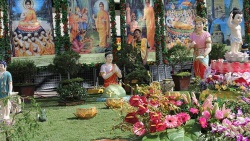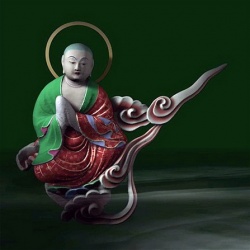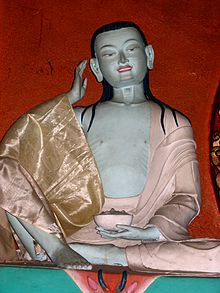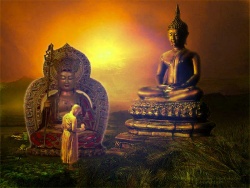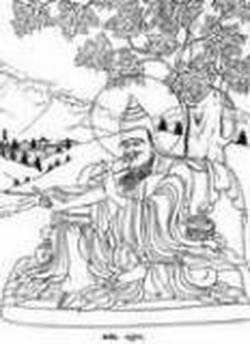Aryadeva
Aryadeva (Skt. Āryadeva; Tib. འཕགས་པ་ལྷ་, Pakpa Lha; Wyl. ‘phags pa lha) (second/third century) — one of the six great commentators (the ‘Six Ornaments’) on the Buddha's teachings.
He was a disciple of Nagarjuna and devoted his life to continuing his master’s work, consolidating the Madhyamika tradition.
He is also counted among the eighty-four mahasiddhas.
(2nd century): One of the "seventeen great panditas" of ancient India and foremost disciple of Nagarjuna.
Author of Four Hundred Verses on the Yogic Deeds of Bodhisattvas (Catuhsataka).
Share on facebook
Aryadeva ('Phags-pa'i lha) was born in Sri Lanka to a royal family, and lived between the middle of the 2nd and the middle of the 3rd centuries C.E. According to some accounts, he was born from a lotus. At an early age, he became a monk and studied the Buddhist scriptures, the Tripitaka, thoroughly there before leaving to South India to study with Nagarjuna in the Shatavahana kingdom of King Udayibhadra. King Udayibhadra was the recipient of Nagarjuna’s Letter to a Friend and The Precious Garland. Aryadeva accompanied Nagarjuna and continued to study with him at Shri Parvata, the holy mountains overlooking modern-day Nagarjunakonda Valley in Andhra Pradesh, within the Shatavahana kingdom.
At that time, Matrcheta, a devotee of Shiva, was defeating everyone at Nalanda in debate. Aryadeva went to meet the challenge. On the way, he met an old woman who was trying to accomplish special powers and, for that purpose, needed the eye of a learned monk. Moved by compassion, he gave her one of his eyes, but when she took it, she simply smashed it with a rock. After that, Aryadeva became well-known as having only one eye. Aryadeva went on to defeat Matrcheta in both debate and special powers and, after that, Matrcheta became his disciple.
Aryadeva stayed at Nalanda for many years. Later in life, however, he returned to Nagarjuna, who entrusted all his teachings to him before he passed away. Aryadeva built many monasteries in that area of South India and taught extensively, establishing the Mahayana tradition and, in particular, the Madhyamaka tenets with his text, Four Hundred Verse Treatise on the Actions of a Bodhisattva’s Yoga (Byang-chub sems-dpa’i rnal-‘byor spyod-pa bzhi-brgya-pa’i bstan-bcos kyi tshig-le’ur byas-pa, Skt. Bodhisattvayogacarya-catuhshataka-shastra-karika). It is known as The Four Hundred or Four Hundred Verse Treatise for short. Like Nagarjuna, Aryadeva too wrote commentaries on the Guhyasamaja Tantra.
Writings
- Four Hundred Verses
- Lamp that Integrates the Practices (Skt. Caryāmelāpaka-pradīpa; Tib. སྤྱོད་པ་བསྡུས་པའི་སྒྲོན་མ་, Wyl. spyod pa bsdus pa'i sgron ma), a treatise on the Guhyasamaja Tantra.
- Shatashastra, which only remains in its Chinese translation by Kumārajīva.
Quotations from Four Hundred Verses
བསོད་ནམས་ཆུང་ངུ་ཆོས་འདི་ལ
ཐེ་ཚོམ་ཟ་བར་ཡང་མི་འགྱུར།
ཐེ་ཚོམ་ཟ་བར་ཙམ་ཞིག་གིས།
སྲིད་པ་ཧྲུལ་པོར་བྱས་པར་འགྱུར།
Those with little merit will not
Even wonder about these things.
But merely to entertain doubts
About saṃsāra will make it fall apart.
- Āryadeva, Four Hundred Verses, VIII, 5
བསོད་ནམས་མིན་པ་དང་པོར་བཟློག །
བར་དུ་བདག་ནི་བཟློག་པ་དང༌། །
ཕྱི་ནས་ལྟ་བ་ཀུན་བཟློག་པ། །
གང་གིས་ཤེས་དེ་མཁས་པ་ཡིན། །
At first, turn away from non-virtue,
In the middle, dispel misconceptions of self,
Finally, go beyond all philosophical views—
One who understands this is wise indeed.
- Āryadeva, Four Hundred Verses, VIII, 15
དངོས་པོ་གཅིག་གི་ལྟ་པོ་གང༌། །
དེ་ནི་ཀུན་གྱི་ལྟ་པོར་བཤད། །
གཅིག་གི་སྟོང་ཉིད་གང་ཡིན་པ། །
དེ་ནི་ཀུན་གྱི་སྟོང་པ་ཉིད། །
Whoever sees the nature of one thing
Is said to see the nature of everything.
For the emptiness of one thing
Is the emptiness of everything.
- Āryadeva, Four Hundred Verses, VIII, 16
Further Reading
- David Seyfort Ruegg, The Literature of the Madhyamaka School of Philosophy in India, Wiesbaden: Harrassowitz, 1981
- Lobsang N. Tsonawa, Indian Buddhist Pandits from The Jewel Garland of Buddhist History, Dharamsala: Library of Tibetan Works and Archives, 1985.
- Christian Wedemeyer, Vajrayāna & Its Doubles: A Critical Historiography, Exposition, and Translation of the Tantric Works of Āryadeva, PhD dissertation, Columbia University (New York 1999).
External Links
Source
Aryadeva
提婆・聖提婆 (n.d.) (Skt; Jpn Daiba or Shodaiba)
Also known as Kanadeva.
A scholar of the Madhyamika school in southern India during the third century and the successor of Nagarjuna.
Born to a Brahman family, he studied the doctrine of nonsubstantiality under Nagarjuna.
One source regards him as a prince of Sri Lanka.
According to The Biography of Aryadeva, he offered one eye to the god Maheshvara at the latter's request.
Because he had only one eye (the Sanskrit kana means one-eyed), he was also called Kanadeva.
He traveled throughout India to instruct the people.
After he defeated non-Buddhist teachers in a religious debate at Pataliputra, he was killed by one of their disciples.
According to the above biography, Aryadeva displayed compassion even during his last moments, telling his assailant about the Buddhist teaching in order to save him.
He wrote The One-Hundred-Verse Treatise, The Four-Hundred-Verse Treatise, and The One-Hundred-Word Treatise.
The One-Hundred-Verse Treatise is one of the three works on which the Three Treatises (Chin Sanlun; Jpn Sanron) school was founded.
Aryadeva is regarded as the fourteenth of Shakyamuni's twenty-three, or the fifteenth of his twenty-four, successors.
He transferred the Buddha's teachings he had received from Nagarjuna to Rahulabhadra.
Source
Aryadeva (Sanskrit: आर्यदेव, Āryadeva) (3rd Century CE), was a disciple of Nagarjuna and author of several important Mahayana Madhyamaka Buddhist texts.
He is also known as Kanadeva the 15th Patriarch in the Zen tradition and Bodhisattva Deva in Sri Lanka where he was born as the son of a king.
Some Chinese sources however, suggest he was born in Southern India in a Brahmanical family.
Most of Aryadeva's works were not preserved in the original Sanskrit, but they mainly survived in Tibetan and Chinese translations.
His best-known text is probably the Catusataka (400 verses), in sixteen chapters of twenty-five stanzas each.
One of his best-known students is Asvagosha.
Several important works of Esoteric Buddhism (most notably the Caryamelapakapradipa or "Lamp that Integrates the Practices") are attributed to Aryadeva.
Contemporary research suggests that these works are datable to a significantly later period in Buddhist history (late ninth or early tenth century), but the tradition of which they are a part maintains that they are (at least in some measure) the work of the Madhyamaka Aryadeva.
Traditional historians (for example, the 17th century Tibetan Tāranātha), aware of the chronological difficulties involved, account for the anachronism via a variety of theories, such as the propagation of later writings via mystical revelation.
A useful summary of this tradition, its literature, and historiography may be found in Wedemeyer 2007.
According to the Drikung Kagyü school of Tibetan Buddhism, Garchen Rinpoche is the current incarnation of Aryadeva.
Texts Attributed to Aryadeva
- Catuhsataka-shastra-nama-karika (the Four Hundred Verses) was translated to English as Aryadeva's Catuhsaka.
On the Bodhisattva's Cultivation of Merit and Knowledge by Karen Lang. Snow Lion Publications published the Four Hundred Verses as Yogic Deeds of Bodhisattvas.
A new edition will be published in 2008 titled: Aryadeva's Four Hundred Stanzas on the Middle Way.
- Aksarasataka (One Hundred Syllables) is sometimes attributed to Nagarjuna
- Hastavalaprakarana (Hair in the Hand) is sometimes attributed to Dignaga and was translated to English as On Voidness.
A Study on Buddhist Nihilism by Fernando Tola and Carmen Dragonetti.


